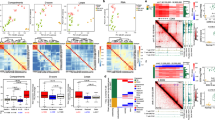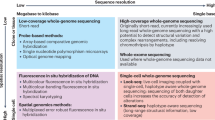Abstract
Cancer cells frequently have disease-specific chromosome rearrangements1,2,3,4. It is poorly understood why translocations between chromosomes recur at specific breakpoints in the genome. Here we provide evidence that higher-order spatial genome organization is a contributing factor in the formation of recurrent translocations. We show that MYC, BCL and immunoglobulin loci, which are recurrently translocated in various B-cell lymphomas, are preferentially positioned in close spatial proximity relative to each other in normal B cells. Loci in spatial proximity are non-randomly positioned towards the nuclear interior in normal B cells. This locus proximity is the consequence of higher-order genome structure rather than a property of individual genes. Our results suggest that the formation of specific translocations in human lymphomas, and perhaps other tissues, is determined in part by higher-order spatial organization of the genome.
This is a preview of subscription content, access via your institution
Access options
Subscribe to this journal
Receive 12 print issues and online access
$209.00 per year
only $17.42 per issue
Buy this article
- Purchase on Springer Link
- Instant access to full article PDF
Prices may be subject to local taxes which are calculated during checkout




Similar content being viewed by others
References
Rowley, J.D. The critical role of chromosome translocations in human leukemias. Annu. Rev. Genet. 32, 495–519 (1998).
Knudson, A.G. Two genetic hits (more or less) to cancer. Nat. Rev. Cancer 1, 157–162 (2001).
Elliott, B. & Jasin, M. Double-strand breaks and translocations in cancer. Cell Mol. Life Sci. 59, 373–385 (2002).
Mitelman, F. Recurrent chromosome aberrations in cancer. Mutat. Res. 462, 247–253 (2000).
Boxer, L.M. & Dang, C.V. Translocations involving c-myc and c-myc function. Oncogene 20, 5595–5610 (2001).
Harris, N.L. et al. New approaches to lymphoma diagnosis. Hematology 2001, 194–220 (2001).
Siebert, R., Rosenwald, A., Staudt, L.M. & Morris, S.W. Molecular features of B-cell lymphoma. Curr. Opin. Oncol. 13, 316–324 (2001).
Willis, T.G. & Dyer, M.J.S. The role of immunoglobulin translocations in the pathogenesis of B-cell malignancies. Blood 96, 808–822 (2000).
Bartova, E. et al. The influence of the cell cycle, differentiation and irradiation on the nuclear location of the abl, bcr and c-myc genes in human leukemic cells. Leuk. Res. 24, 233–241 (2000).
Bartova, E. et al. Nuclear topography of the c-myc gene in human leukemic cells. Gene 244, 1–11 (2000).
Kozubek, S. et al. 3D Structure of the human genome: order in randomness. Chromosoma 111, 321–331 (2002).
Neves, H., Ramos, C., da Silva, M.G., Parreira, A. & Parreira, L. The nuclear topography of ABL, BCR, PML, and RARα genes: evidence for gene proximity in specific phases of the cell cycle and stages of hematopoietic differentiation. Blood 93, 1197–1207 (1999).
Parreira, L. et al. The spatial distribution of human immunoglobulin genes within the nucleus: evidence for gene topography independent of cell type and transcriptional activity. Hum. Genet. 100, 588–594 (1997).
Lukasova, E. et al. Localisation and distance between ABL and BCR genes in interphase nuclei of bone marrow cells of control donors and patients with chronic myeloid leukaemia. Hum. Genet. 100, 525–535 (1997).
Sachs, R.K., Chen, A.M. & Brenner, D.J. Proximity effects in the production of chromosome aberrations by ionizing radiation. Int. J. Rad. Biol. 71, 1–19 (1997).
Parada, L., McQueen, P., Munson, P. & Misteli, T. Conservation of relative chromosome positioning in normal and cancer cells. Curr. Biol. 12, 1692–1697 (2002).
Parada, L. & Misteli, T. Chromosome positioning in the interphase nucleus. Trends Cell Biol. 12, 425–432 (2002).
Chubb, J.R., Boyle, S., Perry, P. & Bickmore, W.A. Chromatin motion is constrained by association with nuclear compartments in human cells. Curr. Biol. 12, 439–445 (2002).
Vazquez, J., Belmont, A.S. & Sedat, J.W. Multiple regimes of constrained chromosome motion are regulated in the interphase Drosophila nucleus. Curr. Biol. 11, 1227–1239 (2001).
Nikiforova, M.N. et al. Proximity of chromosomal loci that participate in radiation-induced rearrangements in human cells. Science 290, 138–141 (2000).
Haigis, K.M. & Dove, W.F. A Robertsonian translocation suppresses a somatic recombination pathway to loss of heterozygosity. Nat. Genet. 33, 33–39 (2003).
Kosak, S.T. et al. Subnuclear compartmentalization of immunoglobulin loci during lymphocyte development. Science 296, 158–162 (2002).
Zhou, J., Ermakova, O.V., Riblet, R., Birshtein, B.K. & Schildkraut, C.L. Replication and subnuclear location dynamics of the immunoglobulin heavy-chain locus in B-lineage cells. Mol. Cell. Biol. 22, 4876–4889 (2002).
Stamatopoulos, K. et al. Molecular insights into the immunopathogenesis of follicular lymphoma. Immunol. Today 21, 298–305 (2000).
Skok, J.A. et al. Nonequivalent nuclear location of immunoglobulin alleles in B lymphocytes. Nat. Immunol. 2, 848–54 (2001).
Yoshida, S. et al. Identification of heterologous translocation partner genes fused to the BCL6 gene in diffuse large B-cell lymphomas: 5′-RACE and LA–PCR analyses of biopsy samples. Oncogene 18, 7994–7999 (1999).
Chapter 14. Statistical description of data.in Numerical Recipes in C (eds. Press, W.H., Teuolskky, S.A., Vettering, W.T. and Flannery, B.P.) 609–655 (Cambridge University Press, Cambridge, 1992).
Stevens, M.A. Kolmogorov-Smernov Statistics. in Encyclopedia of Statistical Science vol. 4 (eds. Kotz, S. and Johnson, N.L.) 393–396 (Wiley and Sons, New York, 1982).
Fienberg, S.E. Contingency Tables. in Encyclopedia of Statistical Science vol. 2 (eds. Kotz, S. and Johnson, N.L.) 161–171 (Wiley and Sons, New York, 1982).
Author information
Authors and Affiliations
Corresponding author
Ethics declarations
Competing interests
The authors declare no competing financial interests.
Rights and permissions
About this article
Cite this article
Roix, J., McQueen, P., Munson, P. et al. Spatial proximity of translocation-prone gene loci in human lymphomas. Nat Genet 34, 287–291 (2003). https://doi.org/10.1038/ng1177
Received:
Accepted:
Published:
Issue Date:
DOI: https://doi.org/10.1038/ng1177
This article is cited by
-
Three-dimensional genome landscape comprehensively reveals patterns of spatial gene regulation in papillary and anaplastic thyroid cancers: a study using representative cell lines for each cancer type
Cellular & Molecular Biology Letters (2023)
-
The 5th edition of the WHO classification of haematolymphoid tumors: comments from the Groupe Francophone de Cytogénétique Hématologique (GFCH)
Leukemia (2023)
-
Automated 3D scoring of fluorescence in situ hybridization (FISH) using a confocal whole slide imaging scanner
Applied Microscopy (2021)
-
Illuminating single genomic loci in live cells by reducing nuclear background fluorescence
Science China Life Sciences (2021)
-
Chromosome structural variation in tumorigenesis: mechanisms of formation and carcinogenesis
Epigenetics & Chromatin (2020)



